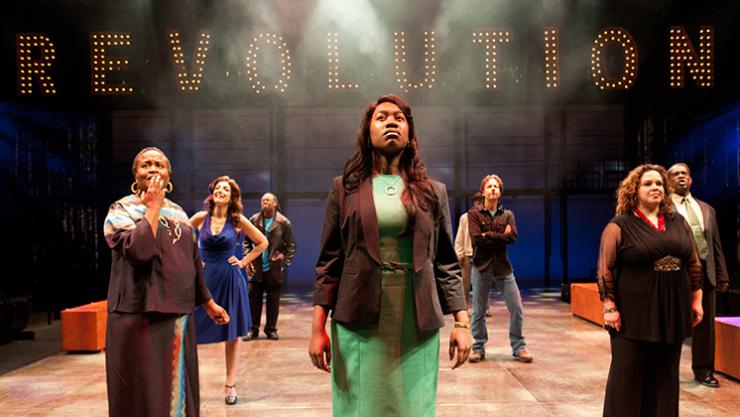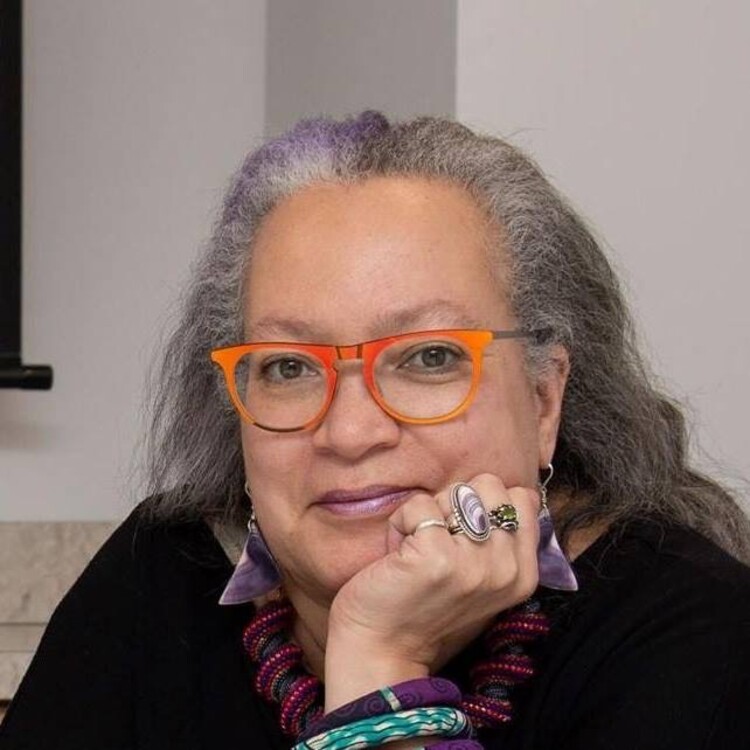Ownership Morphing into Investment
The last five years have been about letting go of some new work development assumptions. One primary assumption is that new work in regional/LORT theaters is only about developing single-author plays. This is not entirely true for Center Theatre Group anymore. And because this is not entirely true for us anymore, I’ve been on a curious expedition trying to figure out how to develop hybrid theater at a theater that has built its legacy on the well-made play and continues to do so.
I went up to Oregon Shakespeare Festival mid-September to see the premier production of UNIVERSES’ Party People, which is an urgent piece about the Black Panthers and the Young Lords. I wish I had stayed longer to see the show a couple of times as it had a wealth of ideas, and a form that I needed to sit with and let sink in if Center Theatre Group is going to give the work its next step. I went up on a scouting mission because most of the CTG artistic staff was traveling up in October to see it, and I felt it would be best to see it first, talk to Mildred, Steve, and William, aka Ninja (UNIVERSES), and ask them what they wanted and needed as their next step. That way I could contextualize for the CTG peeps what to expect and what was needed in the eyes of the artists to fulfill the vision of the work.

This work was an OSF commission, but CTG also gave UNIVERSES what we call a completion commission—a commission that supports an ensemble or a group of hyper-collaborators in order to finish a work. It aligns our resources to suit the needs of where the project is in its development and it helps artists at a crucial moment—when they are in the middle or near the end of a process and resources are wearing thin. Also, we as a theater know more about the piece we’re investing in and are more likely to produce it based on this knowledge while not having carried the entire brunt of the developmental budget. It’s a win for the artists—and a win for us. In exchange for the UNIVERSES’ completion commission—we are in line to produce the piece after its initial premier at OSF here in California. Coupled with this, we had the opportunity to contribute to the dramaturgy of the piece along with OSF throughout its developmental process. This project marks the third collab with the group since the late-90s, so we’ve had a long relationship. This commission was given after we conferred with OSF to let them know of our intentions, and it was wholeheartedly welcomed as the piece was epic and in need of substantial developmental resources and time. In the spring, before the group headed up to Oregon, we brought them along with director Liesl Tommy to Los Angeles to work on the text with one of our dramaturgs, Joy Meads. It proved fruitful, and they developed a genuine rapport with our developmental team—all in preparation for an easier transition once we became responsible for the next step in the process.
In order to wrap our heads around completion commissions, we had to let go of some assumptions.
One assumption was that you don’t dramaturg the work of ensembles or hyper-collaborators in the same way you develop plays. In one way, yes, the rules or non-rules of the hybrid form demand that you don’t try to make the work into a traditional play or musical. This is paramount. But having said that, you still have to assess what the artist is trying to say and ask questions and respond based on what you read or see.
Another assumption was over ownership. Who “owns” the work? Easy answer—the artists own the work and we theatres are the incubators and then the proud grandparents housing the work for the parents who are the creators. The idea of artist investment over time rather than project ownership is a notion we favor in this new developmental world.
The idea of artist investment over time rather than project ownership is a notion we favor in this new developmental world.
Yes, we support the incubation, and it has to happen in Los Angeles. No, it doesn’t. This was another assumption we let go. For example, we gave Austin’s Rude Mechs a completion commission for I’ve Never Been So Happy. We had previously presented Method Gun. We gave them the commission to finish the project in Austin and to premier it at their space, The Off Center. We came to see it in rehearsal and during workshops and gave notes. Then we saw the premiere. We liked what we saw and brought the production to the Kirk Douglas Theater. The piece was developed on Austin soil in front of the company’s own audience. We maximized our investment by letting the development and initial premiere happen in Texas.
Most of the ensembles or hyper-collaborators we have worked with have knowledge of self producing and/or touring. What we found was that the completion commission helps us make our resources go farther by putting the money in the hands of the artists to use as they need instead of us controlling the expenses. In most cases, bringing an ensemble across the country to do a development process can be cost prohibitive, when in reality it's best for the group to develop their work in front of their audience in their space or town. It’s much easier for our staff to go to them rather than the group to come to us.
What has worked in tandem with this model is DouglasPlus, which is a producing/presenting model that allows us to do an unsubscribed run that is shorter and depends on single ticket sales. Instead of feeling that we are a “hotel” and just presenting work that we have no association with, our staff has now assumed an investment and we are presenting work that we have commissioned. Ownership morphs slowly into long-term artist investment in this more expansive world of new play development, where the focus is not only on playwrights but also on ensembles and hyper-collaborators.



Comments
The article is just the start of the conversation—we want to know what you think about this subject, too! HowlRound is a space for knowledge-sharing, and we welcome spirited, thoughtful, and on-topic dialogue. Find our full comments policy here
It's great to see CTG offering workshop/commissions that really lead to productions! Is there any reason this intriguing model could not also work with sole-creator playwrights?
It's also intriguing that your productions of these collaborative pieces are presented on a single ticket sale basis, not as a subscription series. For some time now, I've suspected that the season ticket business model works against the scheduling/production of new plays.
Certainly with alot of contemporary theatre the non-subscription model seems best suited to produce the work. But occassionally we have found work that does cross over. Just this season we did The Elephant Room as a subscription offering and it was a success on many levels including audience engagement-a number of audience members were actually brought on stage. But, you bring up an interesting point why not experiment with a single author play in a non-subscribed run?
How incredibly refreshing and inspiring to hear you talk about artists and their work as an investment to develop rather than a product to be purchased. How much richer the development, how much ultimately stronger the work, how much luckier the audiences, for the daring of CTG to shift their thinking about taking part in new works towards a mode that truly supports the process in which they are made.
Thanks!
Adrienne Makcey
www.swimpony.org
Thanks for this, Diane. You use the word hyper-collaborators a few times in here. Its a term i've never heard. Could you tell me what it means, or what you mean by it? thanks so much.
Obviously, theatre is collaborative. In the traditional model there is a playwright, then, the director and the designers who help us visualize the landscape of a play and the characters within it. However, these collaborators do not have a say in the content of the piece-that is the purview of the playwright. With hyper-collaborators whether they be two artists creating together, one, an auteur director/choreographer and the other a videographer and lighting designer, both artists contribute to the vision and content of the work being created. The work is not the sole vision of a playwright. Hyper-collaborators can also refer to an ensemble that are collectively creating a work or devising it. The word hyper-collaboration acknowledges that the artists involved in a collaboration can be described as more than a designer or a choreographer or a writer or an actor but rather function in multiply ways as content makers and contributors to the overall vision of the work at hand.
so, in your definition, my entire ensemble is a group of hyper-collaborators because they all have dramturgical/authorial voice in the building of our work. However, when we engage non self-defined artist collaborators as research partners, who contribute to the material and the process, then they are collaborators. Unless they do have dramturgical/authorial voice, and then we add the hyper. You are trying to frame authorship in a clearer way. ok. thanks.
That's right, Michael. I like your definition : hyper-collaborators are those creators who have a dramaturgical/authorial voice in the building of work." The word also describes the type of work being built..